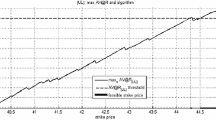Abstract
We consider the problem of optimal management of energy contracts, with bounds on the local (time step) amounts and global (whole period) amounts to be traded, integer constraint on the decision variables and uncertainty on prices only. After building a finite state Markov chain by using vectorial quantization tree method, we rely on the stochastic dual dynamic programming (SDDP) method to solve the continuous relaxation of this stochastic optimization problem. An heuristic for computing sub optimal solutions to the integer optimization problem, based on the Bellman values of the continuous relaxation, is provided. Combining the previous techniques, we are able to deal with high-dimensional state variables problems. Numerical tests applied to realistic energy markets problems have been performed.
Similar content being viewed by others
References
Bally, V., & Pagès, P. (2003a). Error analysis of the quantization algorithm for obstacle problems. Stochastic Processes & Their Applications, 106(1), 1–40.
Bally, V., & Pagès, P. (2003b). A quantization algorithm for solving discrete time multi-dimensional optimal stopping problems. Bernoulli, 9(6), 1003–1049.
Bardou, O., Bouthemy, S., & Pagès, G. (2009). Optimal quantization for the pricing of swing options. Applied Mathematical Finance, 16(2), 183–217.
Bertsekas, D. P., & Tsitsiklis, J. N. (1996). Neuro-dynamic programming. Nashua: Athena Scientific.
Birge, J. R., & Louveaux, F. (2000). Introduction to stochastic programming. New York: Springer.
Black, F. (1976). The pricing of commodity contracts. Journal of Financial Economy, 3, 167–179.
Dupac̆ová, J., Gröwe-Kuska, N., & Römisch, W. (2003). Scenario reduction in stochastic programming—an approach using probability metrics. Mathematical Programming Series A, 95, 493–511.
Eydeland, A., & Wolyniec, K. (2003). Energy and power risk management: new developments in modeling, pricing and hedging. Hoboken: Wiley.
Gordienko, E., Lemus-Rodríguez, E., & Montes-de Oca, R. (2009). Average cost Markov control processes: stability with respect to the Kantorovich metric. Mathematical Methods of Operations Research, 70, 13–33.
Graf, S., & Luschgy, H. (2000). Foundations of quantization for probability distributions. Berlin: Springer.
Heitsch, H., & Römisch, W. (2003). Scenario reduction algorithms in stochastic programming. Computational Optimization and Applications, 24, 187–206.
Heitsch, H., & Römisch, W. (2011). Stability and scenario trees for multistage stochastic programs. In G. Infanger (Ed.), International series in operations research & management science: Vol. 150. Stochastic programming (pp. 139–164). New York: Springer.
Heitsch, H., Römisch, W., & Strugarek, C. (2006). Stability of multistage stochastic programs. SIAM Journal on Optimization, 17, 511–525.
Hoyland, K., Kaut, M., & Wallace, S. W. (2003). A heuristic for moment-matching scenario generation. Computational Optimization and Applications, 24, 169–185.
Infanger, G., & Morton, D. P. (1996). Cut sharing for multistage stochastic linear programs with interstage dependency. Mathematical Programming, 75, 241–256.
Jarrow, R. A., Heath, D. C., & Morton, A. (1992). Bond pricing and the term structure of interest rates: a new methodology for contingent claim valuation. Econometrica, 60, 77–105.
Kall, P., & Wallace, S. W. (1994). Stochastic programming. Chichester: Wiley.
Kaut, M., & Wallace, S. W. (2007). Evaluation of scenario-generation methods for stochastic programming. Pacific Journal of Optimization, 3(2), 257–271.
Küchler, C., & Vigerske, S. (2011). Decomposition of multistage stochastic programs with recombining scenario trees.
Lai, G., Margot, F., & Secomandi, N. (2010). An approximate dynamic programming approach to benchmark practice-based heuristics for natural gas storage valuation. Operational Research, 58, 564–582.
Longstaff, F., & Schwartz, E. (2001). Valuing American options by simulation: a simple least squares approach. The Review of Financial Studies, 14, 113–148.
Mo, B., Gjelsvik, A., & Grundt, A. (2001). Integrated risk management of hydro power scheduling and contract management. IEEE Transactions on Power Systems, 16(2), 216–221.
Pereira, M. V. F., & Pinto, L. M. V. G. (1991). Multi-stage stochastic optimization applied to energy planning. Mathematical Programming, 52, 359–375.
Pflug, G. Ch. (2001). Scenario tree generation for multiperiod financial optimization by optimal discretization. Mathematical Programming Series B, 89, 251–271.
Philpott, A. B., & Guan, Z. (2008). On the convergence of stochastic dual dynamic programming and related methods. Operations Research Letters, 36, 450–455.
Rockafellar, R. T., & Wets, J.-B. (1997). Variational analysis (1st ed.). Grundlehren der mathematischen Wissenschaften. Berlin: Springer.
Van Roy, B., & Tsitsiklis, J. N. (2001). Regression methods for pricing complex American-style options. IEEE Transactions on Neural Networks, 12(4), 694–703.
Shapiro, A. (2011). Analysis of stochastic dual dynamic programming method. European Journal of Operational Research, 209, 63–72.
Shapiro, A., Dentcheva, D., & Ruszczyński, A. (2009). Lectures on stochastic programming: modelling and theory. SIAM: Philadelphia.
Tsitsiklis, J. N. (1997). An analysis of temporal-difference learning with function approximation. IEEE Transactions on Automatic Control, 42(5), 674–690.
Tsitsiklis, J. N., & Van Roy, B. (1999). Optimal stopping of Markov processes: Hilbert space theory, approximation algorithms, and an application to pricing high-dimensional financial derivatives. IEEE Transactions on Automatic Control, 44(10), 1840–1851.
Author information
Authors and Affiliations
Corresponding author
Rights and permissions
About this article
Cite this article
Bonnans, J.F., Cen, Z. & Christel, T. Energy contracts management by stochastic programming techniques. Ann Oper Res 200, 199–222 (2012). https://doi.org/10.1007/s10479-011-0973-5
Published:
Issue Date:
DOI: https://doi.org/10.1007/s10479-011-0973-5




